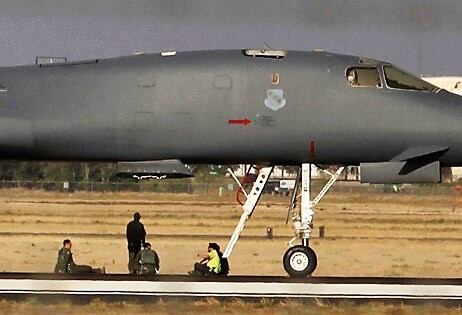The Air Force awarded the Distinguished Flying Cross to all four airmen aboard a stricken B-1 Lancer May 1 for their bravery in staying together as a crew and landing the on-fire bomber safely.
Instructor pilot Maj. Christopher Duhon, weapons system officer instructor Capt. Matthew Leroy Sutton, student pilot 1st Lt. Joseph Welch and student weapons officer 1st Lt. Thomas Ahearn were on a training flight from Dyess Air Force Base, Texas, when they experienced an aircraft fire. The first of the four crew attempted to eject, but the seat did not fire.
“One of the crew members, when they pulled the handles to go, it didn’t function. Within a few seconds, the aircraft commander made the decision to stop the ejection sequence," Air Force Chief of Staff Gen. Dave Goldfein told reporters Tuesday.
The seat’s ejection failed because “there was one particular part that had gotten crimped,” Goldfein said. “So when he pulled the handles, the signal to the ejection sequence didn’t flow."

What happened next was leadership from the instructor pilots and bravery from the airman, who remained in an armed ejection seat for almost 20 minutes, as the crew fought to get the plane landed safely at Midland International Air and Space Port in Texas. If the rest of the crew had decided to eject, it’s likely the trapped airman would not have survived.
"I have never been prouder to wear this uniform than I am today because of you four,” said Air Force Global Strike Command commander Gen. Robin Rand, who presented each airman the Distinguished Flying Cross medal in a ceremony at Dyess on Friday.
The incident led to an Air Force-wide grounding of the B-1s to assess the ejection seats. Goldfein said the bombers were allowed to return to flight because they determined there was an alternate way to fire the seat.
RELATED

But the malfunctioning part on the seat is being replaced throughout the fleet, Goldfein said. He did not name the exact part that malfunctuioned.
“We’re going through the technical change orders to make sure we are changing all those parts to make sure they are full up," Goldfein said.
The incident was not the result of improper maintenance, Goldfein said. The service, like the rest of the military, has been challenged to fill and retain experienced maintainers due to personnel cuts each made in response to the 2013 automatic budget cuts known as sequestration.
“It was more a function of that particular part over time,” Goldfein said. "I think we find this a lot with older weapons systems. Older parts, especially … with parts that are [from] diminishing manufacturers, you know we have single-source suppliers. So I think all of that fed into that.”
Tara Copp is a Pentagon correspondent for the Associated Press. She was previously Pentagon bureau chief for Sightline Media Group.





